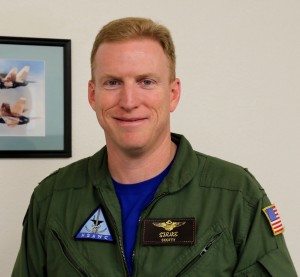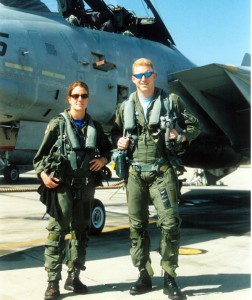2014-11-09 By Robbin Laird and Ed Timperlake
During our visit to the Naval Strike and Air Warfare Center, we had a chance to discuss the approach to strike integration being pursued in the training process at the Center with CDR Charles “Scotty” Brown, current STRIKE XO, previous TOPGUN Instructor. Brown is the N-5 assistant to the department head at Fallon.
“We have an unusual N-5 structure here — we are not about plans and policies.
We are the department charged with strike training and some other miscellaneous pieces as well.
I have been in the Navy for about 21years now and grew up as an F-14 Top Gun pilot.
After doing that for a decade I made the transition to the Super Hornet. And here I am now flying the F-16 as well in the aggressor role.”
“Scotty” explained that many pilots at Fallon are F-16 qualified pilots as well as Super Hornet pilots.
He explained that they do not have full time aggressor pilots and members of NSAWC play that role on a case-by-case basis.

He emphasized that the focus of “Air Wing Fallon is upon integration.
It is about taking all the point nosed squadrons as well as the E-2, the rotary wing, everyone in the air wing, as well as representatives from the air defense commanders from the surface fleet.
Having his OS controllers join us allows us to see a wider range of capability to shape the integration process.
So its about 28 planes working together to put ordinance on target.
At the same time, we seek every opportunity to build in joint assets, such as AWACS, and JSTARS, whether non organic or organic and work to fuse those assets into an integrated operational whole.
He underscored as well that the Fallon model was being replicated elsewhere in the Navy notably with regard to the surface fleet, and as that happens training among the various Navy communities would be facilitated as well.
We are following a stair-step approach.
For example, initially it’s us being able in-house at this location to try and simulate or tie in the surface side to to command-and-control UAS type aircraft or platforms.
But down the road we will be able to tie in potentially with a ship that’s pier-side down in San Diego with the same group that’s up here, and then fuse a picture that allows us to train to a problem set that you we would not be able to otherwise.
He expressed concern about the need to have realistic adversary training and has the threat goes up, “we need to be sure that we can realistically prepare for the threat environment we will face in the years to come.”
“I don’t think flying F-5s will be enough to replicate what an adversary stealth aircraft is going to pose as a challenge.”
Along with others in the command, “Scotty” highlighted the importance of live virtual constructive training in terms of better understanding both the threat as well as the blue assets, which need to be integrated in the fight.
And he argued that as other parts of the Navy established their own LVCT centers, tying these centers together would facilitate the kind of integrated training, which was necessary for 21st century operations.

He highlighted as well the importance of folding in innovations coming to the fleet as part of shaping the training process.
For example, we work closely with VMX-9 at China Lake to work with them in connecting their testing efforts with how those efforts might integrate with the strike force.
They will come up on a routine basis and support NSAWC where we can take a look at some of the newer systems that they have in developmental or operational testing and see what kind of results you get with using those systems.
He noted that in contrast to his last tour at Top Gun, the Center was doing a better job of getting fleet representative aircraft in the flying inventory.
When I was stationed over at the Top Gun side when I was last here, we did not have fleet representative airplanes here.
We did not have the same type of software, and same capability as the planes in the fleet.
And this gap is important to close for realistic training for strike fleet integration.
We will close with a bit of history from “Scotty’s” past.
Two of the most famous F-14 headline making events occurred during the Reagan Presidency. On 8/18/81, early in President Reagan’s 1st term, two F-14s from the VF-41 Black Aces flying off the USS Nimitz (CVN-68) shot down two Libyan Su-22 “Fitters” over the Gulf of Sidra.
The second event had a similar outcome. In the final days of the Reagan administration, two F-14s from the VF-32 Swordsmen shot down two Libyan MiG-23 “Floggers” on 1/4/89. To honor these events in the Reagan Presidency, the Reagan Presidential Library obtained an F-14 for display on the library grounds.
Unfortunately, the actual aircraft involved in the shoot downs were not available so the F-14 obtained by the Library was painted to represent BuNo 160403 flown by the late CDR Hank Kleeman and LT David Venlet in the 1981 event. The actual Tomcat displayed at the Library is BuNo 162592.
The delivery Crew that brought the aircraft to the museum on October 17, 2003 was from MSAWC, with LCDR Charles Scotty Brown and RIO Lt Natalie JJ Good.

